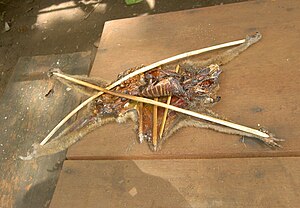Traditional medicine/ja: Difference between revisions
Created page with "=== 民間療法=== thumb|エクアドル、クエンカで''limpieza''を行う[[:en:curandera|キュランデラである。]] 多くの国々には民間医薬品と呼ばれる習慣があり、従来の医療に代表される、正式で科学的根拠に基づいた制度化された医療行為システムと共存している場合がある。民間療法の伝統の例としては、traditional Chin..." Tags: Mobile edit Mobile web edit |
Created page with "===安全性への懸念=== 130カ国が民間薬に関する規制を設けているが、民間薬の使用にはリスクがある(主に動物由来の物質を使用している伝統薬もあるため、人獣共通感染症など)。想定される薬は自然なものだから安全だと思われがちだが、本草学を使用する際には多くの注意事項がある。" Tags: Mobile edit Mobile web edit |
||
| (6 intermediate revisions by the same user not shown) | |||
| Line 53: | Line 53: | ||
多くの国々には民間医薬品と呼ばれる習慣があり、従来の[[medicine/ja|医療]]に代表される、正式で科学的根拠に基づいた制度化された医療行為システムと共存している場合がある。民間療法の伝統の例としては、[[traditional Chinese medicine/ja|中国伝統医学]]、[[Iranian traditional medicine/ja|イラン伝統医学]]、[[traditional Korean medicine/ja|韓国伝統医学]]、[[Medicine in medieval Islam/ja|アラブ土着医学]]、[[:en:Uyghur people|ウイグル]]の伝統医学、日本の[[Kampō/ja|漢方]]医学、アボリジニの伝統的なブッシュ医学、[[:en:Native Hawaiians|ネイティブ・ハワイアン]]の[[:en:Lāʻau lapaʻau|Lāʻau lapaʻau]] 、[[Georgian folk medicine/ja|グルジアの民間療法]]などが挙げられる。 | 多くの国々には民間医薬品と呼ばれる習慣があり、従来の[[medicine/ja|医療]]に代表される、正式で科学的根拠に基づいた制度化された医療行為システムと共存している場合がある。民間療法の伝統の例としては、[[traditional Chinese medicine/ja|中国伝統医学]]、[[Iranian traditional medicine/ja|イラン伝統医学]]、[[traditional Korean medicine/ja|韓国伝統医学]]、[[Medicine in medieval Islam/ja|アラブ土着医学]]、[[:en:Uyghur people|ウイグル]]の伝統医学、日本の[[Kampō/ja|漢方]]医学、アボリジニの伝統的なブッシュ医学、[[:en:Native Hawaiians|ネイティブ・ハワイアン]]の[[:en:Lāʻau lapaʻau|Lāʻau lapaʻau]] 、[[Georgian folk medicine/ja|グルジアの民間療法]]などが挙げられる。 | ||
====オーストラリアのブッシュ医学==== | |||
== | {{main/ja|Bush medicine/ja}} | ||
{{main|Bush medicine}} | 一般に、[[:ja:オーストラリア|オーストラリア]]の[[:en:Aboriginal and Torres Strait Islander people|アボリジニとトレス海峡諸島民]]が使用するブッシュ医学は樹皮、葉、種子などの植物性物質から作られるが、動物性物質も使用されることがある。伝統医学の主要な構成要素は[[herbal medicine/ja|本草学]]であり、天然の植物物質を病気の治療や予防に用いることである。 | ||
==== ネイティブ・アメリカン医学 ==== | |||
=== | {{further/ja|Native American ethnobotany/ja|Traditional Alaska Native medicine/ja}} | ||
{{further|Native American ethnobotany|Traditional Alaska Native medicine}} | [[:en:Indigenous peoples of the Americas|アメリカ大陸の先住民]]や[[:en:Alaska Native|アラスカ先住民]]の医療は、何千年もの間続いてきた伝統的な癒しの形態である。ネイティブ・アメリカンの伝統医療には多くの[[ethnobotany/ja|民族植物学]]の植物が関わっており、いくつかは今日でも使用されている。ネイティブ・アメリカンの伝統医療に関して言えば、文化における健康と病気を取り巻く考え方は、事実上、宗教や精神性の考え方と切り離せないものである。先住民のコミュニティにおけるヒーラーは、[[medicine man/ja|メディスンマン]]やメディスンウーマン、ハーバリスト、あるいはシャーマンに至るまで多くの名前で呼ばれ、それぞれの部族内で精神的あるいは宗教的指導者とみなされている。ヒーリングに関して言えば、部族のヒーラーは植物の特徴を見て、病気の治療に対する有効性を判断していた。植物の形、匂い、色、味といった特定の植物の特徴は、その植物が治療薬としてどのように使えるかを判断するのに役立つ。メスクワキ(Meskwaki)族は、ヘビに噛まれたときに''[[:en:Arum maculatum|アルム・マクラタム]]''の汁が使えることを発見した。これは、ヘビの毒に似ていると言われる植物の汁の乳白色の外観と、植物の形がヘビの頭に似ていることから推測された。アメリカ先住民は[[foxglove/ja|キツネノマゴ]]のハーブを水腫または浮腫と呼ばれる病気の治療薬として使っていた。現代医学では、キツネノマゴのエキスはジギタリスという名で今でも使われており、その目的は心拍数を穏やかにすることである。ネイティブ・アメリカンは、発熱、胃腸の状態、皮膚の発疹、骨折の治療、出産、母親の治癒を助けるなど、いくつかの医療行為で成功を収めていた。ナバホ族のヒーラーが患者を訪問することを許可している[[:en:Indian Health Service|IHS]]の病院内で行われた調査によると、この病院では昏睡状態の患者の意識を取り戻すのに80パーセントの成功率があり、これは現在の生物医学的管理の病院よりも高い率であった。"[[Asteraceae/ja|キク科]]"の植物は、整形外科の補助薬や肺の補助薬としてよく選ばれており、特に''Achillea''と''Artemisia''という種が有名である。北米の14の部族を対象に行われた調査によると、''キク科''が薬効成分として最も広く使用されている植物であることがわかった。 | ||
[[Indigenous peoples of the Americas| | |||
==== ナットゥヴァイディヤム ==== | |||
==== | ナットゥヴァイディヤム(Nattuvaidyam)は、アロパシー医学や西洋医学が登場する以前にインドに存在した一連の土着的な医療行為である。これらの医療行為には、身体、健康、病気に関するさまざまな原理や考え方があった。これらの医療行為には、考え方や使用される薬効成分、技術の重複や借用があった。マラヤーラム語、タミール語、テルグ語などの現地語で書かれたテキストがあるものもあれば、さまざまな記憶法を通じて口頭で伝えられてきたものもある。アーユルヴェーダは南インドで行われていたナットゥヴァイディヤムの一種である。他にも、カラリチキッサ(骨格や筋骨に関連するもの)、マルマチキッサ(バイタルスポットのマッサージ)、オッタムーリヴァイディヤム(一回投与医薬品)、チンタマニヴァイディヤムなどがあった。20世紀のインドで医療制度が見直された際、これらの多様なナットゥヴァイディヤムに特有の実践や技術の多くがアーユルヴェーダに取り入れられた。 | ||
Nattuvaidyam | |||
===家庭療法=== | |||
== | '''家庭療法'''('''おばあちゃん療法'''とも呼ばれることがある)とは、特定の香辛料、[[herbs/ja|ハーブ]]、野菜、その他の一般的なものを用いた[[disease/ja|病気]]や不調を治すための治療法である。家庭療法は、一般的に素人によって伝えられているため(近年では[[:ja:インターネット|インターネット]]によって促進されている)、問題となっている病気や不調を治療したり治したりする[[medicinal properties/ja|薬効]]を持っている場合もあれば、持っていない場合もある。多くは単に[[:en:tradition|伝統]]や[[:en:habituation|習慣]]の結果として、あるいは[[placebo effect/ja|プラセボ効果]]を誘発するのに有効であるために使用されている。 | ||
より一般的な家庭薬の例としては、風邪や軽い[[flu/ja|インフルエンザ]]などの[[Respiratory system/ja|呼吸器]][[infection/ja|感染]]の治療に[[:en:chicken soup|チキンスープ]]を使うことがある。その他の家庭療法の例としては、骨折を治すための[[:en:duct tape|ガムテープ]]、[[:en:plantar wart|足底疣贅]]を治すためのガムテープや瞬間接着剤、喉の痛みを治すための[[:en:Kogel mogel|コーゲルモーゲル]]などがある。その昔は、深刻な治療法以外はすべて母親に任されていた。歴史的な[[:en:cookbook|料理本]]には、[[dyspepsia/ja|消化不良]]、発熱、女性の不定愁訴のための治療薬がよく載っている。[[aloe vera/ja|アロエベラ]]の成分は皮膚疾患の治療に用いられる。ヨーロッパの多くの[[:en:List of liqueurs|リキュール]]や[[:en:Apéritif and digestif|ディジェスティフ]]は元々薬として売られていた。中国の民間療法では、薬効のある[[:en:congee|粥]](薬草入りの長時間煮込んだ米のスープ)、食品、スープが治療法の一部となっている。 | |||
==批判== | |||
{{Anchor|Criticism}} | |||
===安全性への懸念=== | |||
== | 130カ国が民間薬に関する規制を設けているが、民間薬の使用にはリスクがある(主に動物由来の物質を使用している伝統薬もあるため、[[zoonosis/ja|人獣共通感染症]]など)。想定される薬は自然なものだから安全だと思われがちだが、本草学を使用する際には多くの注意事項がある。 | ||
===絶滅危惧種の使用=== | ===絶滅危惧種の使用=== | ||
Latest revision as of 22:26, 17 March 2024


| この記事は、下記シリーズの一部分 |
| Alternative medicine/ja |
|---|
 |
伝統医学(土着医学または民間療法とも呼ばれる)は、近代医学の時代以前に、先住民を含む様々な社会の民間信仰の中で何世代にもわたって発展した伝統的知識の医学的側面から構成される。世界保健機関(WHO)は伝統医学を「説明可能か否かを問わず、異なる文化に固有の理論、信念、経験に基づく知識、技術、実践の総体であり、健康維持や身体的・精神的疾患の予防、診断、改善、治療に用いられる」と定義している。伝統医学はしばしば科学的医学と対比される。
一部のアジアおよびアフリカ諸国では、人口の80%までがプライマリーヘルスケアの必要性を伝統医学に依存している。伝統医療は代替医療の一形態である。伝統医学として知られる実践には、ヨーロッパの伝統医学、伝統的な中国医学、伝統的な韓国医学、伝統的なアフリカ医学、アーユルヴェーダ、シッダ医学、ウナニ、古代イラン医学、イラン伝統医学、中世イスラム医学、ムーティ、イファ、ロンゴアなどがある。伝統医学を研究する科学分野には、本草学、民族医学、民族植物学、医療人類学などがある。
しかしWHOは、「伝統的な薬や習慣の不適切な使用は、否定的または危険な影響を及ぼす可能性がある」とし、そのような習慣や伝統的な医療システムで使用される薬用植物の「有効性と安全性を確認するためには、さらなる研究が必要である」と指摘している。伝統医療戦略2014-2023』では、WHOは「伝統医療が人々の健康維持に果たす役割を強化するために、加盟国が積極的な政策を策定し、行動計画を実施することを支援する」と述べている。
使い方と歴史
古典史
文字による記録では、薬草の研究は5000年前の古代シュメール人にまでさかのぼる。古代エジプト医学では、紀元前1552年頃のエベルス・パピルスに民間療法と魔法のような医療行為のリストが記録されている。旧約聖書にもカシュルートに関してハーブの使用と栽培について言及されている。
アーユルヴェーダで使用される多くのハーブやミネラルは、紀元前1千年紀にチャラカやスシュルタといった古代インドの薬草学者によって記述されたものである。中国最初の漢方書は漢代に編纂された神農本草経であったが、それよりも遥かに古く、後に唐代に瑶興論(薬草の性質に関する論)として増補された。現存する、そして現在の薬草知識の初期のギリシア人編纂者には、ピタゴラスとその追随者たち、ヒポクラテス、アリストテレス、テオフラストス、ディオスコリデス、ガレノスなどがいる。
ローマ時代の典拠としては、長老プリニウスのNatural HistoryやケルススのDe Medicinaなどがある。ペダニウス・ディオスコリデスのDe Materia Medicaは、それ以前の著者を参考にし、多くの新資料を加えて修正された。この著作はいくつかの言語に翻訳され、トルコ語、アラビア語、ヘブライ語の名前が数世紀にわたって加えられた。ラテン語のDe Materia Medicaの写本はApuleius Platonicusによるラテン語の本草書(Herbarium Apuleii Platonici)と組み合わされ、アングロサクソン写本のCotton Vitellius C.IIIに組み込まれた。これらの初期のギリシア・ローマの編纂物はヨーロッパの医学理論の基幹となり、ペルシアのアヴィセンナ(Ibn Sīnā, 980-1037)、ペルシアのラーズィー(Rāzi, 865-925)、ユダヤのマイモニデスによって翻訳された。
一部の化石は古代から伝統医学に用いられてきた。
中世以降
アラビア固有の医薬品は、ベドウィンの魔術に基づく医薬品と、ヘレニズムやアーユルヴェーダの伝統医学のアラビア語翻訳との対立から発展した。スペインの医学は711年から1492年までアラブの影響を受けていた。アル=ディナワーリーやイブン・アル=バイタルのようなイスラムの医師やイスラム植物学者は、マテリア・メディカの以前の知識を大きく発展させた。最も有名なペルシアの医学書はアヴィセンナのThe Canon of Medicineであり、これは初期の薬局方であり、臨床試験を導入した。カノンは12世紀にラテン語訳され、17世紀までヨーロッパにおける医学の権威であり続けた。伝統医学のユナニシステムもカノンに基づいている。
初期のローマ・ギリシア語編纂物のドイツ語への翻訳はヒエロニムス・ボックによって行われ、1546年に出版されたその本草書はKreuter Buchと呼ばれた。この本はRembert Dodoens(1517年-1585年)によってPemptadesとしてオランダ語に翻訳され、Carolus Clusius(1526年-1609年)によってオランダ語から英語に翻訳され、Henry Lyteによって1578年にA Nievve Herballとして出版された。 これがジョン・ジェラード(1545-1612)のHerball or General Historie of Plantesとなった。各新作は既存のテキストに新たな追加を加えたものであった。
女性の民間知識は、これらのテキストと並行して、文書化されていない形で存在していた。ディオスコリデスが言及した44の薬物、希釈剤、香料、エモリエント剤は、今でもヨーロッパの公式薬局方に記載されている。ピューリタンはジェラードの研究をアメリカに持ち込み、アメリカの先住民の医学に影響を与えた。
スペインのフィリップ2世の侍医であったフランシスコ・ヒメネスは1571年から1577年にかけてメキシコで情報を収集し、Rerum Medicarum Novae Hispaniae Thesaurusを著した。フランシスコ・ヒメネスによるものも含め、多くのバージョンが出版されている。エルナンデスもヒメネスもアステカの民族医学的な情報を「温かい」「冷たい」「湿っている」といったヨーロッパの病気の概念に当てはめたが,アステカ人がこのような分類を用いていたことは明らかではない。Juan de EsteynefferのFlorilegio medicinal de todas las enfermedasはヨーロッパのテキストを編集し、35のメキシコの植物を追加した。
マルティン・デ・ラ・クルスがナワトル語で書いた本草書は、フアン・バディアーノによってLibellus de Medicinalibus Indorum HerbisまたはCodex Barberini, Latin 241としてラテン語に翻訳され、1552年にスペイン王カルロス5世に献上された。フレイベルナルディーノ・デ・サハグンは民族誌学的手法で写本を編纂し、1793年に出版されたHistoria General de las Cosas de Nueva Españaとなった。カストーレ・デュランテは1585年にHerbario Nuovoを出版し、ヨーロッパと東洋と西インド諸島の薬用植物を記述した。1609年にドイツ語に翻訳され、その後1世紀にわたってイタリア語版が出版された。
植民地時代のアメリカ
17世紀から18世紀にかけてのアメリカでは、伝統的な民間療法家(多くは女性)が薬草療法、カッピング、リーチングを用いていた。ネイティブ・アメリカンの伝統的な本草学は、マラリア、赤痢、壊血病、非性梅毒、甲状腺腫の問題の治療法を紹介した。これらの薬草や民間療法の多くは、19世紀から20世紀まで続き、一部の植物薬は現代薬理学の基礎を形成した。
現代の使用法
世界の特定の地域における民間療法の普及率は、文化的規範によって異なる。現代医学の中には、民間療法で使用されていた植物植物化学物質に基づいているものもある。研究者らは、代替療法の多くは「統計的に偽薬治療と区別できない」と述べている。
知識の伝達と創造
土着医学は一般的に「収集」されるまで、共同体、家族、個人を通じて口頭で伝達される。ある文化圏において、土着医学の知識の要素は、多くの人々によって広く知られている場合もあれば、シャーマンや助産婦のような特定の役割のヒーラーによって集められ、適用される場合もある。ヒーラーの役割を正当化する3つの要因、すなわち彼ら自身の信念、彼らの行動の成功、そしてコミュニティの信念である。ある文化圏で土着医学の主張が否定されるようになっても、一般的に3つのタイプの信奉者がまだそれを利用している-生まれながらにしてその中で社会化され、永続的な信奉者となる者、危機的な時にそれを利用する一時的な信奉者、そして特定の側面だけを信じ、そのすべてを信じない者である。
定義と用語
伝統医学は民間療法とは区別され、民間療法の公式化された側面を含むと考えられることもある。この定義のもとでは、民間療法とは素人によって受け継がれ、実践されてきた長年の治療法および実践法を指す。民間療法は、ある文化圏の一部の人々に知られている治療様式、身体生理学および健康保持に関する考え方、一般的知識として非公式に伝えられているもの、およびその文化圏の経験者であれば誰でも実践または適用しているものである。
民間療法

多くの国々には民間医薬品と呼ばれる習慣があり、従来の医療に代表される、正式で科学的根拠に基づいた制度化された医療行為システムと共存している場合がある。民間療法の伝統の例としては、中国伝統医学、イラン伝統医学、韓国伝統医学、アラブ土着医学、ウイグルの伝統医学、日本の漢方医学、アボリジニの伝統的なブッシュ医学、ネイティブ・ハワイアンのLāʻau lapaʻau 、グルジアの民間療法などが挙げられる。
オーストラリアのブッシュ医学
一般に、オーストラリアのアボリジニとトレス海峡諸島民が使用するブッシュ医学は樹皮、葉、種子などの植物性物質から作られるが、動物性物質も使用されることがある。伝統医学の主要な構成要素は本草学であり、天然の植物物質を病気の治療や予防に用いることである。
ネイティブ・アメリカン医学
アメリカ大陸の先住民やアラスカ先住民の医療は、何千年もの間続いてきた伝統的な癒しの形態である。ネイティブ・アメリカンの伝統医療には多くの民族植物学の植物が関わっており、いくつかは今日でも使用されている。ネイティブ・アメリカンの伝統医療に関して言えば、文化における健康と病気を取り巻く考え方は、事実上、宗教や精神性の考え方と切り離せないものである。先住民のコミュニティにおけるヒーラーは、メディスンマンやメディスンウーマン、ハーバリスト、あるいはシャーマンに至るまで多くの名前で呼ばれ、それぞれの部族内で精神的あるいは宗教的指導者とみなされている。ヒーリングに関して言えば、部族のヒーラーは植物の特徴を見て、病気の治療に対する有効性を判断していた。植物の形、匂い、色、味といった特定の植物の特徴は、その植物が治療薬としてどのように使えるかを判断するのに役立つ。メスクワキ(Meskwaki)族は、ヘビに噛まれたときにアルム・マクラタムの汁が使えることを発見した。これは、ヘビの毒に似ていると言われる植物の汁の乳白色の外観と、植物の形がヘビの頭に似ていることから推測された。アメリカ先住民はキツネノマゴのハーブを水腫または浮腫と呼ばれる病気の治療薬として使っていた。現代医学では、キツネノマゴのエキスはジギタリスという名で今でも使われており、その目的は心拍数を穏やかにすることである。ネイティブ・アメリカンは、発熱、胃腸の状態、皮膚の発疹、骨折の治療、出産、母親の治癒を助けるなど、いくつかの医療行為で成功を収めていた。ナバホ族のヒーラーが患者を訪問することを許可しているIHSの病院内で行われた調査によると、この病院では昏睡状態の患者の意識を取り戻すのに80パーセントの成功率があり、これは現在の生物医学的管理の病院よりも高い率であった。"キク科"の植物は、整形外科の補助薬や肺の補助薬としてよく選ばれており、特にAchilleaとArtemisiaという種が有名である。北米の14の部族を対象に行われた調査によると、キク科が薬効成分として最も広く使用されている植物であることがわかった。
ナットゥヴァイディヤム
ナットゥヴァイディヤム(Nattuvaidyam)は、アロパシー医学や西洋医学が登場する以前にインドに存在した一連の土着的な医療行為である。これらの医療行為には、身体、健康、病気に関するさまざまな原理や考え方があった。これらの医療行為には、考え方や使用される薬効成分、技術の重複や借用があった。マラヤーラム語、タミール語、テルグ語などの現地語で書かれたテキストがあるものもあれば、さまざまな記憶法を通じて口頭で伝えられてきたものもある。アーユルヴェーダは南インドで行われていたナットゥヴァイディヤムの一種である。他にも、カラリチキッサ(骨格や筋骨に関連するもの)、マルマチキッサ(バイタルスポットのマッサージ)、オッタムーリヴァイディヤム(一回投与医薬品)、チンタマニヴァイディヤムなどがあった。20世紀のインドで医療制度が見直された際、これらの多様なナットゥヴァイディヤムに特有の実践や技術の多くがアーユルヴェーダに取り入れられた。
家庭療法
家庭療法(おばあちゃん療法とも呼ばれることがある)とは、特定の香辛料、ハーブ、野菜、その他の一般的なものを用いた病気や不調を治すための治療法である。家庭療法は、一般的に素人によって伝えられているため(近年ではインターネットによって促進されている)、問題となっている病気や不調を治療したり治したりする薬効を持っている場合もあれば、持っていない場合もある。多くは単に伝統や習慣の結果として、あるいはプラセボ効果を誘発するのに有効であるために使用されている。
より一般的な家庭薬の例としては、風邪や軽いインフルエンザなどの呼吸器感染の治療にチキンスープを使うことがある。その他の家庭療法の例としては、骨折を治すためのガムテープ、足底疣贅を治すためのガムテープや瞬間接着剤、喉の痛みを治すためのコーゲルモーゲルなどがある。その昔は、深刻な治療法以外はすべて母親に任されていた。歴史的な料理本には、消化不良、発熱、女性の不定愁訴のための治療薬がよく載っている。アロエベラの成分は皮膚疾患の治療に用いられる。ヨーロッパの多くのリキュールやディジェスティフは元々薬として売られていた。中国の民間療法では、薬効のある粥(薬草入りの長時間煮込んだ米のスープ)、食品、スープが治療法の一部となっている。
批判
安全性への懸念
130カ国が民間薬に関する規制を設けているが、民間薬の使用にはリスクがある(主に動物由来の物質を使用している伝統薬もあるため、人獣共通感染症など)。想定される薬は自然なものだから安全だと思われがちだが、本草学を使用する際には多くの注意事項がある。
絶滅危惧種の使用

スローロリスのような絶滅危惧種の動物は、伝統的な薬を作るために殺されることもある。
フカヒレは伝統医療にも使われており、その有効性は証明されていないが、サメの個体数と生態系に打撃を与えている。
違法な象牙取引は、部分的には伝統中国医学の買い手にまで遡ることができる。象牙の需要は、サイやゾウといった絶滅危惧種の密猟の大きな要因となっている。
パンゴリンは、その肉と伝統医療に使われるウロコのために密猟の脅威にさらされている。世界で最も密売されている哺乳類である。
こちらも参照
- Ayurveda/ja
- Bioprospecting/ja
- Folk healer/ja
- 本草学
- Jarrah (surgeon)/ja
- Medicinal plants/ja
- Native American ethnobotany/ja
- Old wives' tale/ja
- Pharmacognosy/ja
- Traditional African medicine/ja
- Traditional Chinese medicine/ja
- Traditional Knowledge Digital Library/ja
- List of forms of alternative medicine/ja
外部リンク
 Media related to Traditional medicine at Wikimedia Commons
Media related to Traditional medicine at Wikimedia Commons
